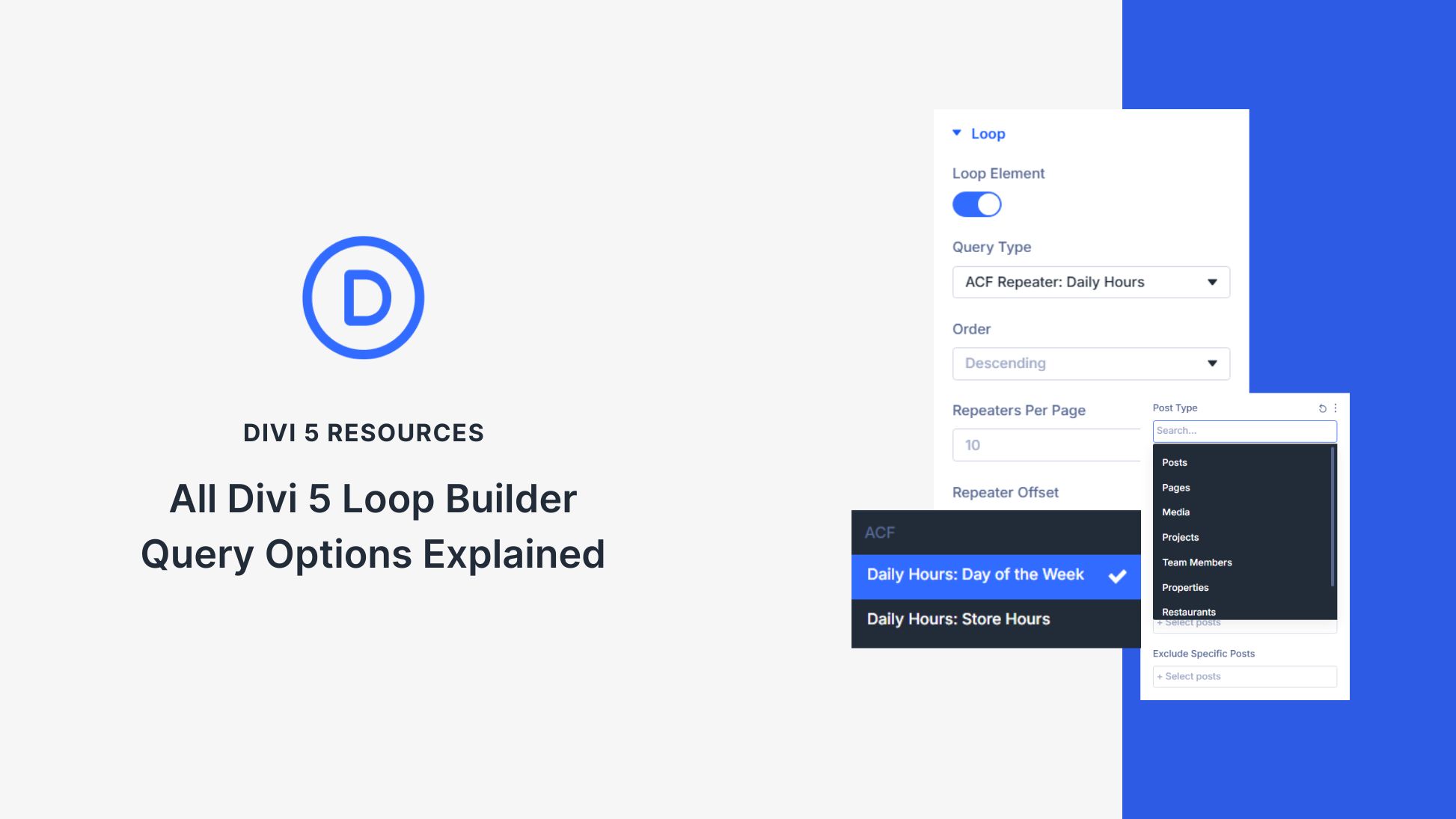Blog
All Divi 5 Loop Builder Query Options Explained

Understanding the Query Options in Divi 5 Loop Builder
Divi 5’s Loop Builder is a game-changer for web designers and developers. One of its standout features is the flexible query options that cater to diverse content display needs. This guide will break down these query options, illustrating how you can effectively utilize them to enhance your website’s aesthetics and functionality.
What is the Loop Builder?
Before diving into the specific query options, let’s clarify what the Loop Builder is. The Loop Builder allows you to create custom layouts for displaying content. Whether you’re building a blog, portfolio, or e-commerce site, you can leverage the Loop Builder to present your posts dynamically and engagingly.
Why Query Options Matter
Query options dictate what content gets displayed through the Loop Builder. By customizing these options, you can tailor your site’s content output to match user intent, improve engagement, and enhance SEO performance. Effective use of query options can lead to a better user experience and, ultimately, higher conversion rates.
Types of Query Options in Divi 5 Loop Builder
Divi 5 provides various query options to help you customize the content display effectively. Let’s explore these options in detail.
1. Post Type Selection
Choosing the right post type is fundamental in shaping what your audience sees. Divi 5 allows you to select from:
- Blog Posts: Ideal for articles and updates.
- Pages: Useful for static content.
- Custom Post Types: Perfect for portfolios, testimonials, and more.
Selecting the correct post type allows you to filter and display only the relevant content.
2. Filter by Categories
Categories are essential for organizing content. Divi 5 enables you to filter posts by specific categories, ensuring that your users find what they want quickly.
- Single Category: Display posts from one category.
- Multiple Categories: Showcase a combination of posts from different categories.
Using categories wisely can enhance navigation and keep visitors engaged longer.
3. Tag Filters
Tags complement categories by offering a more granular approach to content classification. With Divi 5, you can specify tags to filter your content, enabling users to discover similar items easily.
- Single Tag: Highlight posts associated with one specific tag.
- Multiple Tags: Combine posts across different tags for broader reach.
Customizing Query Order
The sequence in which your posts appear can influence user behavior. Divi 5 provides flexible order options to optimize how content is presented to visitors.
1. Order By Options
You can choose how to sort your posts using several parameters:
- Date: Show the latest content first.
- Title: Sort by alphabetical title order.
- Random: Display posts in a random sequence for a fresh look each visit.
- Comments: Prioritize posts with higher engagement through comments.
Leveraging the right order option can guide users toward important content and maintain their interest.
2. Order Direction
Once you’ve determined how to order your posts, you can also set its direction:
- Ascending: Start from the oldest to the newest.
- Descending: Begin with the latest, moving backward.
Choosing the right direction aligns with your content strategy and user expectation.
Pagination and Load More Options
Managing how users navigate through content is crucial for user experience. Divi 5 offers pagination and Load More options to streamline access to additional posts:
- Pagination: Break content into manageable pages.
- Load More Button: Allow users to load additional content without reloading the page.
Both options have pros and cons, and the choice often depends on the overall design and user journey you envision.
Managing Pagination
When employing pagination, you can customize how many posts appear on each page. Setting an optimal number helps maintain page load speeds while providing sufficient content visibility.
Here are a few tips:
- Aim for 5-10 posts per page for quicker navigation without overwhelming users.
- Test different settings to see what keeps users engaged on your site.
Filter by Post Status
Divi 5 Loop Builder also accommodates various post statuses, which can be handy for different use cases.
- Published: Show only content that is live.
- Draft: View posts that are still in progress.
- Pending Review: Display content awaiting approval.
This flexibility is particularly useful for team-based projects where multiple contributors may be involved.
Advanced Query Options
For those looking to take their content management a step further, Divi 5 offers advanced query options that allow complex filtering:
- Meta Queries: Tailor content based on specific metadata.
- Date Queries: Display posts from a certain period, enhancing relevancy.
These advanced features can connect dynamic content with user interests, creating a highly personalized browsing experience.
Utilizing Query Options for SEO
Optimizing your query options is integral for SEO. By tailoring your content display, you not only enhance user experience but also improve search engine visibility.
Tips for Effective SEO with Query Options
-
Keyword Optimization: Use relevant keywords in post titles and content, ensuring that they align with your chosen query options.
-
Structured Content: Leverage categories and tags effectively, as search engines often parse these structures to understand site context.
- Engaging Visuals: Incorporate images or videos to complement your content, enhancing user retention and encouraging shares.
Conclusion
The Loop Builder in Divi 5, coupled with its comprehensive query options, empowers developers and designers to create customized, engaging websites that resonate with their audience. By understanding and effectively utilizing these options—ranging from post types and categories to advanced filtering—you can significantly enhance both user experience and SEO performance.
As you embark on your creative journey with Divi 5, remember that every query option is a tool to help you mold your site according to your vision and your audience’s needs. Experiment, analyze, and refine your approach to discover what truly works best for your content goals.

